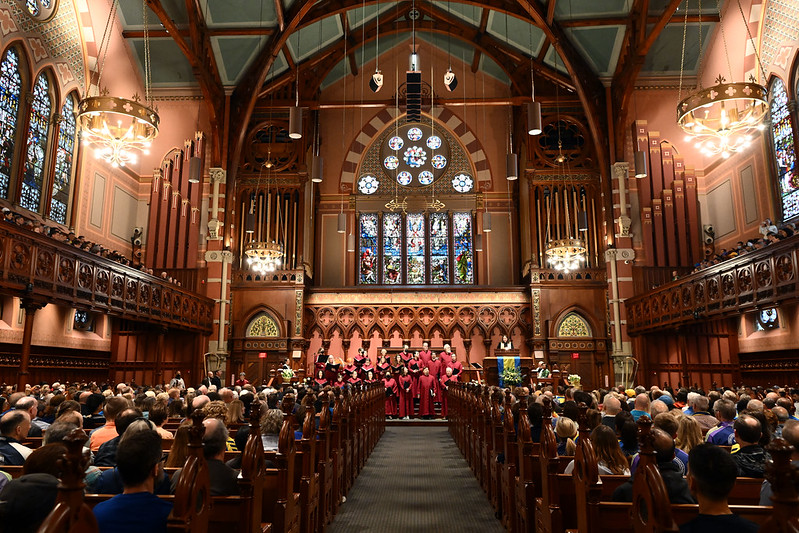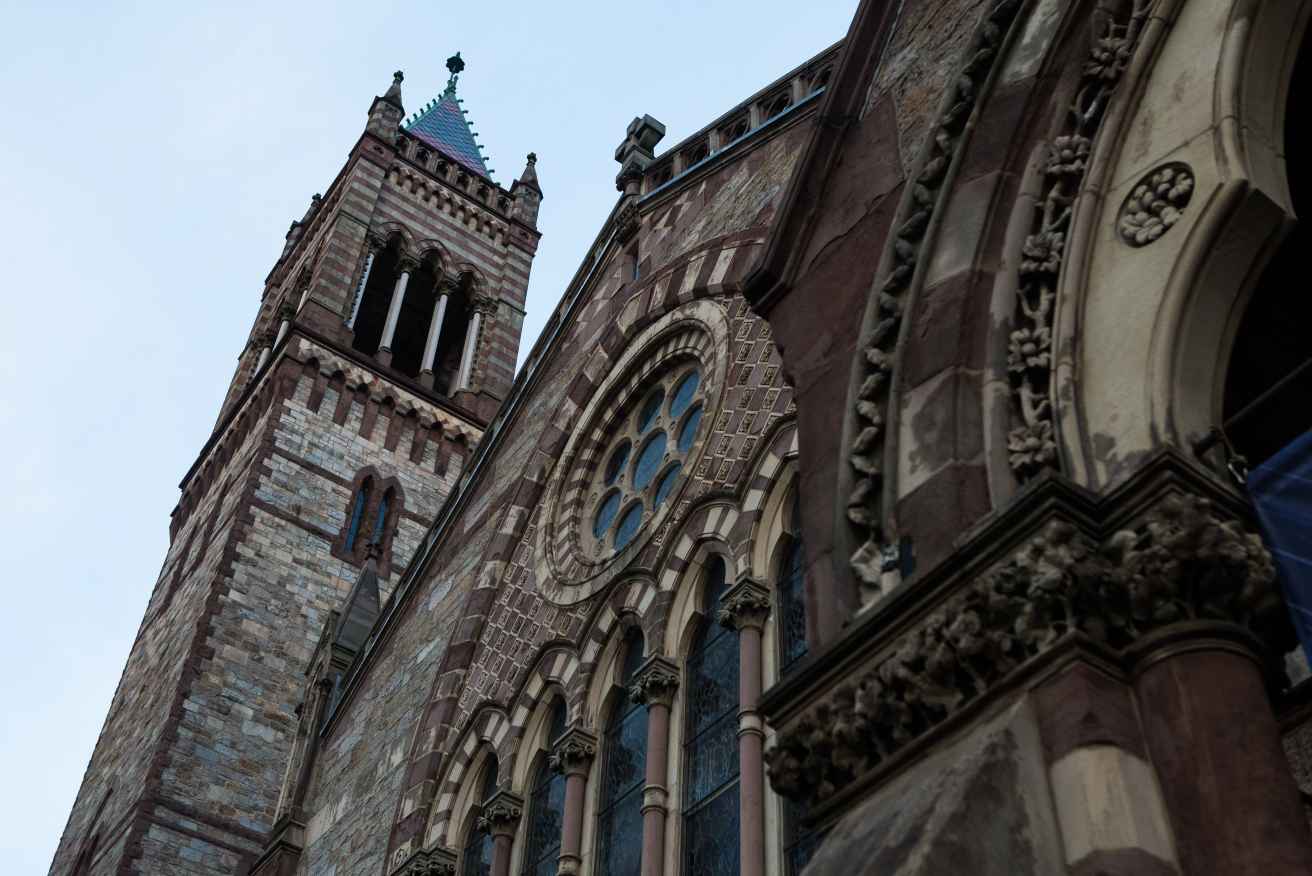Festival Worship - Care of Creation Sunday
Festival Worship - Care of Creation Sunday
Green Man
Transcript
Will you pray for me? Lord, may the words of my lips and the meditations of all our hearts be acceptable in your sight, our Rock and our Redeemer. Amen.
They’re easy to miss, but once you start looking for them, it seems you find them all over the place. If you go just about anywhere in Western Europe, and you go to almost any Medieval church or cathedral there and you search carefully enough, you will probably find one. And then you will start to see them everywhere.
They peep down from far dark corners. They leer at you from roof bosses high above your head. They glare up from choir stalls and pulpits. They vomit in your direction from corbels and lintels and capitals. They peer enigmatically from shadowy and unexpected places. And you, standing there in church, can’t help but wonder how somebody like that managed to get into a nice place like this.
They are the Green Men. A Green Man is, basically, a carving of a man whose face is surrounded by or made from leaves. They strike one as enigmatic, old, mysterious, and distinctly pagan despite their almost always being found in churches. They come in three basic forms. The least common is simply a human face peering through a screen of leaves; picture your neighbor spying on you through the hedge in the back yard.
Far more common is the form they call a “foliate head.” These are just what they sound like: faces formed from the foliage itself, often acanthus or oak leaves.
Probably the most common type of all is what they indelicately call the “disgorging type.” The disgorging Green Man is a man’s face with an open mouth out of which pours vegetation: maybe laden grapevines that twine around columns, or acanthus leaves with birds perching in them, or oak branches and acorns that spread and swirl dramatically to form a support or a buttress. Sometimes the foliage springs from eyes, or ears, or nose as well, but always from the mouth, and always it gives the impression of movement and power, of twisting and growing with speed, like it’s exploding from the Green Man’s mouth, already overwhelming his own head, and about to take over the world as well.
Some of the Green Men have impish smiles on their faces, but most are not happy. A few look sad, many more look downright angry, but most—especially the disgorging ones, look like they’re in a great deal of pain. Their lips pull back over their teeth, their foreheads wrinkle, their eyebrows pull up and together in terrible grimaces as the foliage bursts forth. It would appear that producing so much life hurts.
Europe’s Green Men have captivated, delighted, and frightened tourists and worshipers for hundreds of years. They just seem too wild, too pagan even for the builders of medieval cathedrals, who were very willing indeed to incorporate imagery that was not, strictly speaking, Christian into their buildings. There are, as you might guess, as many theories out there as there are scholars who study the Green Men.
But almost all the scholars, the Christian ones who want to tame the Green Men and the neo-pagan ones who want to set them free and everybody in between, almost every one of them will tell you this: whoever or whatever the Green Men are supposed to be, they are not Jesus. The scholars really, really want you to get this point, and so they all say it over and over again: there is no way, no way at all, that the Green Men represent Jesus Christ.
I don’t know what the stonemasons and the bishops and whoever were trying to communicate with these guys any more than the scholars do. But an image of one whose Word is growing and abundant? An image of one who opens his mouth and life flows out? An image of one who is by turns sad and angry and who produces lush life—beautiful, powerful, scary—that’s about to overwhelm the dry stones that surround him? An image of one who produces all this at great pain to himself? Maybe that’s some pagan nature God, but it sure looks like Jesus to me.
At about the same time some of those guys were building their cathedrals, a German abbess was locked up in her rooms at the convent, having mystical visions of God. Hildegard of Bingen was easily one of the best-educated Europeans of her day: literate, intelligent, accomplished, powerful, theologically astute. Her visions of God and Heaven were strange and beautiful, and compelling to her contemporaries and to many right up to today. Popes and princes corresponded with her. She wrote multiple books and supervised their illumination. She composed thousands of pieces of music, many of which are still performed today. At a time when women’s roles were prescribed and circumscribed indeed, she went on four separate preaching tours of Europe, where the greatest and holiest listened to what she had to say about God.
One of the central pieces of the theology she created from her received visions was “viriditas.” Viriditas is a term Hildegard herself coined. It is her word for Christ’s power made manifest on earth. It is sometimes translated to English as “fecundity” or “fertility”; more often, it is translated as “greening.” Not “greenness,” not “verdure,” but “greening.” Viriditas is more a verb than a noun; it is a vital moving, a growing, an unfolding, a blossoming. For Hildegard, the best symbol of Christ’s power is the greening of the world, the bursting forth of lushness and the rising smell of earthiness and the twining round of everything that is too hot or too cold or too hard or too dead with rich, exuberant life. For Hildegard, God was the font from which life proceeded, and that life was green. She did not call Jesus a Green Man, but I bet she would think the name apt.
Hildegard lived largely surrounded by the great primeval forests of Europe, and it is worth noting here that for the most part, people of her day did not consider those forests to be friendly places. The dim woods were where fell beasts and dangerous spirits and wild men lived. Both imaginary dangers and very real ones lurked in those green shadows, and anything could happen in the woods. Forests were to be conquered, subdued, or avoided. And yet, this woman who so well knew the dangers of lush green places conceived of the goodness and the power of God in exactly those terms.
You see, for Hildegard, there was a worse danger in the world than the forest primeval: the desert. There is an opposing force, in Hildegard’s mind, to viriditas. She called it “ariditas.” Dryness (you can hear that word “arid” in there). Ariditas is creeping dryness, lifelessness, hot barrenness, desertification. And it is this lifelessness, this lack of moisture and greenness, that God seeks to conquer with viriditas, with the greening power that proceeds from Christ’s own self to take over the desert of the souls and of the world.
Now, the authors of our Bible were, largely, a desert people. They lived and roamed in arid places, where green things were scarce, and what natural growth there was usually small, and sparse, and twisted and thorny. The average inhabitant of Israel spent a fair portion of her or his day dealing with the heat and the dryness and the sun, either looking for shade, or hauling water, or moving as swiftly as possible from one watering hole to another.
Some places in Israel were green and fertile—for instance, the Galilee, significantly where Jesus spent his childhood, is fertile, and moist, and fragrant. But most are harsh and forbidding, the kind of place where a mistake of navigation or planning could, and often did, lead to death. Dryness, aridity were everywhere, and cold everywhere at night and they were often deadly. It can be the kind of place where you might think that ariditas is winning.
Unsurprising, then, that when these people cast their minds back to imagine paradise, they imagined that garden, Eden, where everything was green, and cool, and fresh, and fragrant. And unsurprising too, if they thought that a garden full of viriditas was their first home, that they might, reflecting on their current home, believe that they were being punished and long for someone to shepherd them back to verdant places.
So it is that in the part of John’s vision we heard today, the reign of God is conceived in this way. No one will be thirsty ever again. The burning sun will never strike anybody down again. And Jesus will lead the people to the good places, the watering places, the green places. When it seems that the desert is winning, he will guide us through and take us to the places that the life springs forth.
But this vision? This vision is only a part of the story. For you see there is a problem with this vision: in it, the desert still exists.
But if you turn to the end of the Book of Revelation, John’s vision goes still further, like this: From the throne of God will flow the river of the water of life—a whole river of viriditas—right through the place where the people live. And growing up from that river, a tree the likes of which you have never seen. Did you see “Avatar”? Bigger than Home Tree. Did you see “The Lord of the Rings”? Bigger than Galadriel’s tree. Bigger than sequoias. Bigger than skyscrapers. The kind of tree that could only come from the heart of the God of life. A tree of unimaginable proportions with branches big enough to shade all that ever lived or ever will live. That tree, fed by the power and the word of God, will produce enough food for all of Heaven. And the sweet green light that falls through those leaves will be the healing of the nations. And the desert that is forever creeping forward to overtake the world will be no more.
The Bible starts in a green garden and ends in the dappled green light of the tree of life. In between, the people will in fact pass through the desert. In between the people will even—God forgive us—help the desert to advance sometimes, and ariditas will come close to winning. But here’s the thing: we have a guide, a shepherd that will bring us to green places. He went lifeless down into the ground in the desert. But then he sprang up and opened his mouth, and the greening poured forth, and though it hurt, and though it was not easy, it will not let the desert win.
Don’t you want to be on the side of viriditas? Don’t you want to follow the Green Man through the desert to the green places and then make them spread until they have taken over every dry place? Don’t you want to open yourself up until the life flows out of you to overwhelm the world? Don’t you want to beat the desert back, in the world and in your soul? Don’t you want to turn to the back of your bulletin and find ways to green the world? Don’t you want to look at the insert in your bulletin and find a way to make viriditas flow right out onto Boylston Street?
Don’t you want to make your life green? Not just environmentalist green, not just “buy a Prius and recycle” green, but green like the Green Man, alive like the Lamb, dappled like the green light of heaven, moist and earthy and fragrant and fruitful and full of God’s own life, just a little wild, just a little pagan, just a little in touch with the woods and the wild and the Word, just enough to help them overwhelm the world?
It may be that the builders and carvers of the Green Men were sneaking some pre-Christian nature spirit into their churches. But just ‘cause it’s pre-Christian doesn’t mean it’s wrong.
And maybe. Maybe all those designers and builders, all across Europe and all across several centuries carved what they carved because they knew the same truth. Maybe the Holy Spirit whispered the same thing to all of them. Maybe She told them the same thing She told the pagans of Europe before the Christians came, and the same thing She told John, and Hildegard, and the guys that built this place with its flowers and trees, and the Old South gardeners: that God is the source and fountain of all that is good and growing. That what comes from the mouth of Jesus Christ is life, life that will never stop until it has covered every arid place, life that will flow even when it hurts God to make it happen. That what God is always, always about, then and now and until we all lie back in the shade of that big tree, is overwhelming death with life.
And this, maybe She told them this most of all: that life is, first and foremost, green.
Amen.







